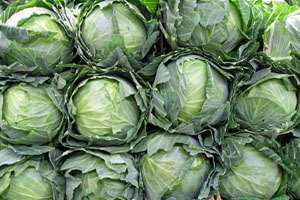Posted by · 1 Comment
 I believe sauerkraut was one of those accidental discoveries. Someone put cabbage in a vessel and just, plain, forgot about it. I’ve done that; who hasn’t? Typically, it’s something in the very back of the refrigerator though… resulting in a finale not quite as pleasant as sauerkraut.
I believe sauerkraut was one of those accidental discoveries. Someone put cabbage in a vessel and just, plain, forgot about it. I’ve done that; who hasn’t? Typically, it’s something in the very back of the refrigerator though… resulting in a finale not quite as pleasant as sauerkraut.
It’s easy to think of “kraut” being a German “discovery,” isn’t it? After all, it’s a typical pairing on a German dinner plate.
Believe it or not, the beginnings of sauerkraut actually date back a full 2,000 years—to the Chinese laborers building the Great Wall. At that time, apparently the cabbage was fermented in rice wine, whereas today we know kraut-making as a “dry method” of salting the cabbage to extract the natural juices in which it will ferment. It’s believed to have spread to present-day Europe as nomadic tribes made their way to those parts—picture Genghis Khan, plundering all the way, energized by a crock of kraut!
Captain James Cook, the 18th Century Pacific explorer, always took a store of sauerkraut on his sea voyages, since experience had taught him that it was an effective preventative of scurvy.
So, sauerkraut fed laborers who eventually crafted a man-made wonder which can be seen from space, nourished nomadic tribes as they made their way around the world, and kept sea-farers free of scurvy. Nothing in the back of my fridge could ever fuel such remarkable accomplishments… but that’s why I have sauerkraut on standby.



How long do you let the cabbage set in crock?